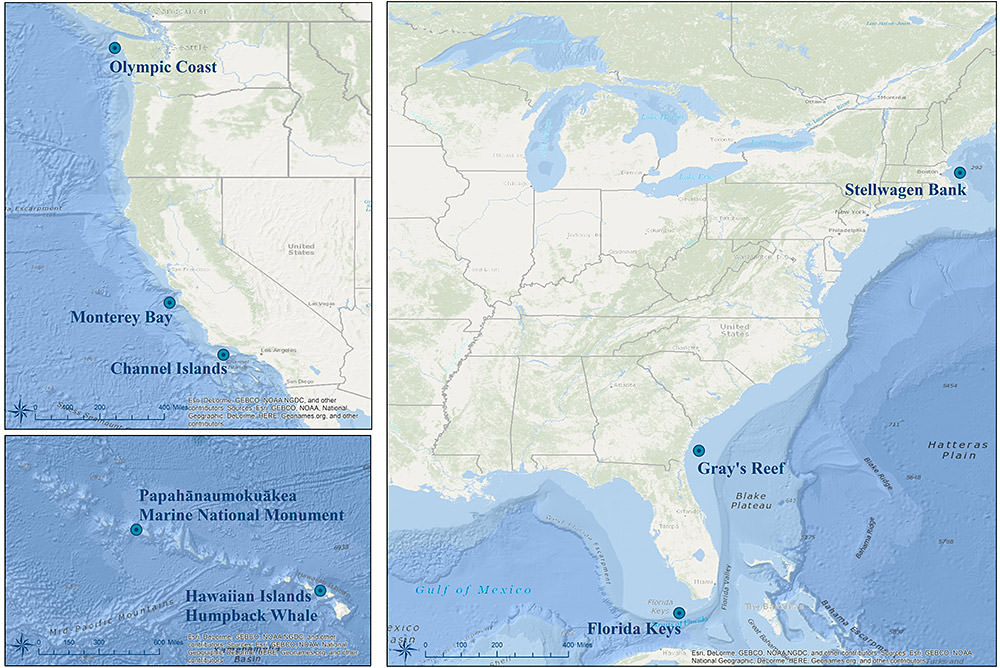Bocaccio Sound Production Recorded at SanctSoundSite CI01_01
This record represents bocaccio calls detection from raw passive acoustic data. Calls
were detected automatically using Triton's Fish Detector. Recordings were first decimated
to a sample rate of 2 kHz. The fish detector filtered the time series between 100
and 950 Hz, and computed cross-correlation between the envelope of a filtered example
call and 75s of the envelope of the filtered time series. To detect signals within
varying background noise, we used a floating threshold of the median cross correlation
value over the current 75 s of data, with a threshold offset of 2e-9 above the median.
Detections were evaluated if they reached above this threshold. Consecutive calls
were required to have a minimum time gap of 0.5 s to be detected separately. RMS received
level was computed over the potential detection period and a time series of the length
of the bocaccio call template before and after the detection. Detections were considered
false and discarded if the signal-to-noise ratio between the detection period and
the timeseries before and after the detection was less than 0.01. The threshold was
evaluated based on the distribution of histograms of manually verified true and false
detections. A trained analyst verified the detections as true or false.These data
were recorded at SanctSound Site CI01_01 between October 31, 2018 and February 20,
2019.
- Cite as: NOAA Office of National Marine Sanctuaries and U.S Navy. 2021. Bocaccio Sound Production Recorded at SanctSoundSite CI01_01, SanctSound Data Products. NOAA National Centers for Environmental Information. https://doi.org/10.25921/nz5v-qx57. [access date].
- 10.25921/nz5v-qx57
- NCEI Metadata ID: gov.noaa.ncei.pad:NOAA-Navy-SanctSound_CI01_01_bocaccio
gov.noaa.ncei.pad:NOAA-Navy-SanctSound_CI01_01_bocaccio
| Search Data |
|
| Download Data |
|
| Distribution Formats |
|
| Ordering Instructions | Contact NCEI for other distribution options and instructions. |
| Distributor | NOAA National Centers for Environmental Information ncei.info@noaa.gov |
| Dataset Point of Contact | NOAA National Centers for Environmental Information ncei.info@noaa.gov |
| Dataset Point of Contact | Carrie Wall NCEI Passive Acoustic Archive Lead NOAA National Centers for Environmental Information pad.info@noaa.gov |
| Coverage Description | Site CI01_01 |
| Time Period | 2018-10-31T22:00:00Z to 2019-02-20T09:00:09Z |
| Spatial Bounding Box Coordinates |
West:-120.0811
East:-120.0811
South:34.0438
North:34.0438
|
| Spatial Coverage Map | |
| General Documentation | |
| Associated Resources |
|
| Publication Dates |
|
| Edition | Final SanctSound Data Product |
| Dataset Progress Status | Complete - production of the data has been completed |
| Data Update Frequency | As needed |
| Purpose | These data are available to the public for a wide variety of uses including scientific research and analysis. |
| Dataset Citation |
|
| Cited Authors |
|
| Principal Investigators |
|
| Publishers |
|
| Acknowledgments |
|
| Theme keywords | Global Change Master Directory (GCMD) Science Keywords
|
| Data Center keywords | Global Change Master Directory (GCMD) Data Center Keywords
|
| Platform keywords | Global Change Master Directory (GCMD) Platform Keywords
|
| Instrument keywords | Global Change Master Directory (GCMD) Instrument Keywords
|
| Place keywords | Global Change Master Directory (GCMD) Location Keywords
|
| Project keywords | Global Change Master Directory (GCMD) Project Keywords
|
| Use Constraints |
|
| Access Constraints |
|
| Other Constraints | Cite as: NOAA Office of National Marine Sanctuaries and U.S Navy. 2021. Bocaccio Sound Production Recorded at SanctSoundSite CI01_01, SanctSound Data Products. NOAA National Centers for Environmental Information. https://doi.org/10.25921/nz5v-qx57. [access date]. |
| Fees |
|
| Processing Steps |
|
| Instrument |
|
| Platform |
|
Last Modified: 2023-06-15
For questions about the information on this page, please email:ncei.info@noaa.gov
